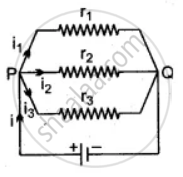Advertisements
Advertisements
प्रश्न
Suppose there are three resistors A, B, and C having resistances r1, r2, and r3 respectively. If R represents their equivalent resistance, establish the following relation `1/"R" = 1/"r"_1 + 1/"r"_2 + 1/"r"_3`, when joined in parallel.
उत्तर
When joined in parallel, let the main current be i which sub-divides at P into i1 in r1, i2 in r2 and i3 in r3 respectively in given figure.
If potential difference across PQ be V then,
According to Ohm's law:
i1 = Vr1 ...(i)
i2 = Vr2 ....(ii)
and i3 = Vr3 ...(iii)
If R'' be the equivalent resistance of this combination, then
i = `"V"/"R''"` ....(A)
From (i), (ii) and (iii) on adding, we get ....(B)
i = i1 + i2 + i3
`= "V"/"r"_1 + "V"/"r"_2 + "V"/"r"_3`
`= "V"(1/"r"_1 + 1/"r"_2 + 1/"r"_3)`

Comparing (A) and (B)
`"V"/"R''" = "V"(1/"r"_1 + 1/"r"_2 + 1/"r"_3)`
or `1/"R''" = 1/"r"_1 + 1/"r"_2 + 1/"r"_3`
APPEARS IN
संबंधित प्रश्न
How much work is done in moving a charge of 2 C across two points having a potential difference of 12 V?
What is the potential difference between the terminals of a battery if 250 joules of work is required to transfer 20 coulombs of charge from one terminal of battery to the other?
The device used for measuring potential difference is known as:
Name a device which helps to maintain potential difference across a conductor (say, a bulb).
Name the law which relates the current in a conductor to the potential difference across its ends.
What is the ratio of potential difference and current known as?
A p.d. of 10 V is needed to make a current of 0.02 A flow through a wire. Wire p.d. is needed to make a current of 250 mA flow through the same wire?
A current of 200 mA flows through a 4 kΩ resistor. What is the p.d. across the resistor?
Calculate the power used in the 2 Ω resistor in each of the following circuits: a 6 V battery in series with 1 Ω and 2 Ω resistors.
Point out two differences between e.m.f. and potential difference as applied to electric circuits.
